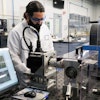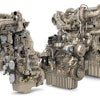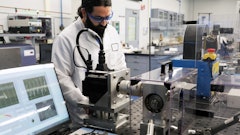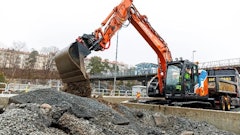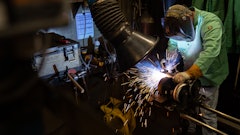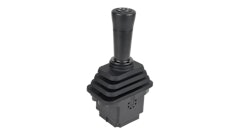Any manufacturer or fabricator wondering if best practices such as "kaizen" and "5S" produce tangible results need look no further than OEM Fabricators, Woodville, WI.
Kaizen events are projects used to eliminate waste, while 5S (sort, simplify, sweep/shine, standardize, sustain) is a technique for visual work place organization where any tools and materials not needed for the job are removed.
Putting kaizen and 5S into action in May, 2004, OEM Fabricators has streamlined operations by standardizing on one wire, one gas and one welding system for nearly all mild steel weldments, from 1/8-in. and up. Where an ER70S-6 wire provides acceptable mechanical properties, OEM Fabricators now uses .045 ER70S-6 wire, 90/10 argon/CO 2 shielding gas and the Accu-Pulse (GMAW-P) welding process provided by 28 new Axcess multi-MIG welding systems from Miller Electric Mfg. Co. As a result, OEM has reduced welding costs up to $2,000 per day and is scheduled to pay for its new welding systems in approximately six months.
OEM Fabricators works with original equipment manufacturers, offering fabrication, welding, machining, shot blasting, painting and assembly services. The company serves more than 80 customers, with a focus on those in construction and agricultural equipment. OEM fabricates a variety of components from carbon steel, stainless steel and aluminum.
The source of waste
Many of the welding procedures given to OEM Fabricators by its customers were established 20 or 30 years ago and haven't changed since. The weldments required for the fabrication of heavy construction and ag equipment often include a variety of different materials, joint combinations and positions, and the old technology often required that the welder stop to change shielding gas and wire.
"In addition to losing 15 minutes every time the operators stopped to change gas and wire, along with changing weld parameters, there's the clean-up time," says Scott Exner, manufacturing engineer. "Anytime I see a weld with grinding marks all over it, the first thing I look at is how much we paid a guy to do that. I calculated that a lot of our welding cells have lost up to 2.75 hours of productivity per 10-hour shift due to the older welding technology and its inherent disadvantages."
OEM had heard that GMAW-P could potentially eliminate productivity losses. In the past, the company tested Miller's inverter power sources paired with 60M feeders for GMAW-P, as well as GMAW-P systems from other manufacturers.
"Until the introduction of the Axcess system we had not found a welding system that would cover the diverse needs of our job shop environment, be teachable and user-friendly," says Exner. "I couldn't fine-tune the arc without being a rocket scientist. With the technology being so complicated, the operators had a hard time learning it and in some cases the frustration level was so high that they would not accept the system."
Then he heard about Miller's newest pulsed MIG system and attended a demonstration. Within two months, more than a dozen Axcess systems were in place at OEM. The Axcess multi-MIG welding system is a digital system that combines flexible power conversion hardware with welding application software. It can produce nearly any physical arc characteristic or waveform.
An interface prompts operators to enter the wire type, wire diameter, gas combination and process desired. The power source then selects the data from its library of application software to provide the best solution. The operator then selects the desired wire feed speed and the system keeps a constant arc length throughout the appropriate range.
Axcess power supplies are available in models that produce 300, 450 or 675-amp outputs, so it will match any service application from the manual welding of thin gauge material to heavy automated production runs.
Training
AccuPulse changed Exner's mind because it is more controllable and easy to teach. The AccuPulse process controls both current and voltage to stay within the optimum range for a specific wire type and diameter, wire feed speed and gas combination (other pulsed spray transfer technology only controls current). The AccuPulse control scheme starts by ramping up the current. Once the target current is reached at the beginning of each phase, the constant current (CC) control turns off and the constant voltage (CV) control loop turns on. The CV loop modulates the current within a range that maintains the target voltage. This is independent of the contact tip to work distance, which allows AccuPulse to perform with very short arc length characteristics that optimize welding performance and operator appeal.
Exner knew he needed to implement a training program to obtain all of the benefits the technology could provide. He notes that welding operators are special, as there are not too many people who will sit under the hood on an 85 F day with 100% humidity and watch a 6,000 F arc on a hot piece of steel. And, "after 25 years, they have an internal comfort level of feeling that they're in complete control of their world. When something new is presented, it brings them out of that comfort zone and could potentially make them look bad. We had to convince the operators that the new tool is actually a better tool, and to do that, they had to feel in their heart that it provides them with better control."
Exner walks groups of six to eight people through the advantages and disadvantages of each process, then goes on to explain the equipment: how to turn on the power source, set up the wire, set machine parameters, strike an arc and perform basic arc tuning.
While explaining GMAW-P, he shows a video on old pulsing technology that goes through calculating peak and background currents. "I give everybody a note pad and have them start taking down the figures and calculations," he says. "A lot of them get frustrated. Then I shut the video off and say, 'Throw your notebook away, you don't need it.' That delivers the message that Miller's new GMAW-P technology isn't hard."
Exner then takes the group to a new system on the shop floor and shows them how to set up a program, adjust arc length and arc control and set wire feed speed.
"The Axcess/AccuPulse combination further simplifies training because it adapts to individual operator preferences and does not force the operator to adapt to the machine," Exner states. "Typically, operators prefer to hold a short arc length because it gives them better control over the molten weld puddle. With older pulsing technology, different arc lengths sound, feel and look different."
"AccuPulse keeps the arc length the same. It doesn't matter what you do with travel speed or how much stick-out you hold. This is a big benefit when welding corners. It lets you come into the corner with a push technique, then move out of the corner with a drag technique. There's no worry about the arc stumbling and the porosity that could result. You don't have to waste an hour grinding out a bad weld and repairing it."
OEM welder Brad Henze previously used a traditional inverter welding machine combined with the Miller 60M before switching to the Axcess system. "It was a total difference," Henze says. "The welds are a lot smoother and penetration is better. You can control your arc length. I've actually pulled it away about 2 1/2 in. before the arc goes out."
Customers see benefits
With the ability to set weld parameters, all operators working with the Axcess system "primarily use the same arc length and arc control settings," says Exner. "Once they set those two numbers, all they have to adjust is wire feed speed. This is important from a quality aspect. With older technology, we could not get the same operator-to-operator consistency."
As with many digital power sources and wire feeders, the Axcess system enables locking parameters within a set range specified by the engineer.
"Right now we're documenting programs for different cells and finding out what numbers work," Exner says. "Eventually, we will program the feeders down to two or three programs with locked ranges. This way, an inexperienced welder can hardly go wrong. Basically, he has to turn the welding machine on and weld. He doesn't have to get caught up in the engineering."
Axcess is also upgradable. Because welding processes and arc performance in Axcess are created and controlled by computer-type software, the hardware remains a fixed investment while the software enables upgrades as welding needs change. The ability to exchange software, or welding programs, already benefits one of OEM's largest customers.
"We do a great deal of work for a large manufacturer of construction equipment that also uses the Axcess system and AccuPulse process," notes Exner. "They can send us, via e-mail, a program that I can put on to my hand-held computer and from there we can program our welder. Now our guys weld exactly the same way their guys do, even though they're miles away."
Money saved
In theory, with the GMAW-P waveform, the peak current pinches off a spray-transfer droplet and propels it toward the weldment for good fusion. The background current maintains the arc but is too low for metal transfer to occur. With no metal transfer, the weld puddle gets a chance to cool, providing out-of-position spray transfer welding capability. The degree of this benefit is determined by the ability of the power supply to sense and respond to variation in contact tip to work distance and change the pulse frequency accordingly. Most pulsed systems use this technique today with the exception of the Miller Axcess system featuring AccuPulse.
AccuPulse allows the current to regulate itself within a specified range at peaks, maintaining constant voltage and automatically adapting to changes in contact tip to work distances. Shorter arc lengths, more control and increased usable process wire feed speed ranges are allowed. This ability enabled Exner to implement his rule of ones: one wire, one gas and one welding system.
It started by substituting AccuPulse for short circuit transfer. When the operator uses a slower wire feed speed, the system automatically produces a cooler arc. This allows OEM to weld thin material; for them, this is steel 1/8 to 1/4-in. thick.
While AccuPulse can easily weld 1/8-in. steel without burn-through (using a .045-in. solid wire), the pulse of peak current provides excellent fusion at the toes of the weld. Conversely, the short circuit process is highly susceptible to cold lap (cold lap is a weld flaw in which the hot weld puddle spills over the toes of the weld and does not produce the right penetration profile. When it occurs, the weld must be repaired).
As an added benefit, AccuPulse has helped OEM increase travel speeds by 10 to 15% compared to short circuit MIG, and Exner sees it reaching to 25% when parameters and operators are optimized.
For welding thicker sections with AccuPulse, operators simply increase the wire feed speed and the system automatically adjusts other pulsing variables. Previously, OEM operators first needed to weld thinner sections with GMAW and clean up the spatter associated with short circuit transfer, then change wire and gas to weld materials above 1/4 in. With FCAW, operators wasted time removing slag. Further, due to the nature of the large weldments at OEM, operators often needed to change welding parameters several times.
"If a guy is welding a 5 ft. cube, he might have some verticals, some horizontals, some flat welds, some different joint combinations and different material thicknesses to deal with," says Herb Peter, Oxygen Services Co. representative, St. Paul , MN . "With old technology, they might have to crawl out of a 20-in. hole to reset the welder or reposition the weldment six or eight times."
"With Axcess and its trigger program select (TPS), they set everything in advance," Peter continues. "Operators run sample pieces of those different joint combinations and find their preferred wire feed speed, arc length and arc control. Then, just by clicking the trigger on the gun, they can sequentially scroll through programs. They don't have to set the gun down or reposition the weldment. Whether they want a hot program with a wide bead for welding in the flat position, a cold program with a narrow bead for overhead welding or they need to go into a corner or around a circle, TPS allows them to select the program they want and weld without interruption."
OEM's goal of one wire, one gas, one machine and one process has become a reality. Through the realization of this goal, Exner estimates that the company eliminates up to 2.75 unproductive hours per welder, per day. With a labor rate averaging $25 to $32 per hour, OEM has the potential to save up to $80 per day per employee.
